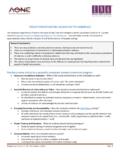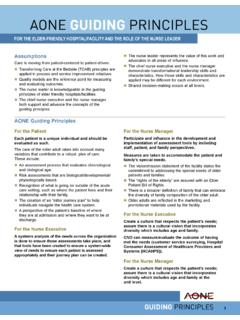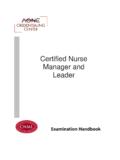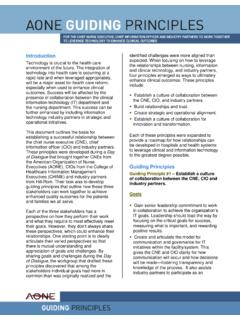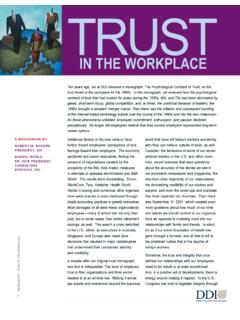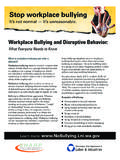Transcription of AONE Guiding Principles Mitigating Violence in the …
1 Mitigating Violence IN THE workplace . Introduction workplace Violence is an increasingly recognized safety issue in the health care community. workplace Violence is generally defined as any act or threat of physical assault, harassment, intimidation and other coercive behavior. It also includes lateral Violence , or bullying, between colleagues ( nurse/nurse, doctor/nurse, etc.). In 2010, the Bureau of Labor Statistics data reported health care and social assistance workers were the victims of approximately 11,370. assaults by persons.
2 While workplace Violence against health care professionals can and does happen everywhere, the hospital emergency department is among the most vulnerable settings. According to a 2011 study by the Emergency Nurses Association (ENA), percent out of 6,504. emergency nurses experienced physical Violence and/or verbal abuse from a patient and/or visitor during the past week. The actual rate of incidences of Violence is much higher as many incidents go unreported, due in part to the perception that assaults are part of the job . The American Organization of Nurse Executives (AONE) and ENA convened a Day of Dialogue to discuss how incidents of Violence are currently addressed in hospitals, as well as the need to create an environment where health care professionals, patients and families feel safe.
3 The outcome of the meeting was the development of Guiding Principles , as well as a tool kit, to assist nurse leaders in systematically addressing measures to decrease and control Violence in the workplace . The focus of these resources is the hospital setting; additional work is needed to address workplace Violence across the care continuum. The Guiding Principles and priorities listed below are steps to systematically reduce lateral, as well as patient and family Violence in the work place. Guiding Principles 1. Recognition that Violence can and does happen anywhere.
4 2. Healthy work environments promote positive patient outcomes. 3. All aspects of Violence (patient, family and lateral) must be addressed. 4. A multidisciplinary team, including patients and families, is required to address workplace Violence . 5. Everyone in the organization is accountable for upholding foundational behavior standards, regardless of position or discipline. 6. When members of the health care team identify an issue that contributes to Violence in the workplace , they have an obligation to address it. 7. Intention, commitment and collaboration of nurses with other health care professionals at all levels are needed to create a culture shift.
5 8. Addressing workplace Violence may increase the effectiveness of nursing practice and patient care. 1 Mitigating Violence IN THE workplace . Five Priority Focus Areas 1. Foundational behaviors to make this framework work: Respectful communication, including active listening Mutual respect demonstrated by all ( members of the multidisciplinary team, patients, visitors and administrators). Honesty, trust and beneficence 2. Essential elements of a zero-tolerance framework: Top-down approach supported and observed by an organization's board and C-Suite Enacted policy defining what actions will not be tolerated, as well as specific consequences for infractions to the policy Policy is clearly understood and equally observed by every person in the organization ( leadership, multidisciplinary team, staff, patients and families).
6 Lateral Violence is prohibited, regardless of role or position of authority ( the standard of behavior is the same for doctors, nurses, staff and administration). 3. Essential elements to ensuring ownership and accountability: Personal accountability, meaning everyone in the organization is responsible for reporting and responding to incidents of Violence Zero-tolerance policy is developed with input from staff at every level in the organization, thus ensuring staff co-own the process and expectations Universal standards of behavior are clearly defined and every person in the organization (including patients and families)
7 Is held equally accountable Incidents of Violence are reported immediately to persons of authority, through the chain of command, to ensure immediate enforcement of the zero-tolerance policy 4. Essential elements of training and education on workplace Violence : Organizational and personal readiness to learn Readily available, evidence-based and organizationally-supported tools and interventions Skilled/experienced facilitators who understand the audience and specific issues Training on early recognition and de-escalation of potential Violence in both individuals and environments Health care specific case studies with simulations to demonstrate actions in situations of Violence 5.
8 Outcome metrics of the program's success: Top ranked staff and patient safety scores Incidence of harm from violent behavior decreases Entire organization (staff) reports feeling very safe on the staff engagement survey Patients and families report feeling safe in the health care setting Staff feels comfortable reporting incidents and involving persons of authority The organization reflects the following culture change indicators: employers are engaged, employees are satisfied and HCAHPS scores increase. 2 Mitigating Violence IN THE workplace .
9 Participants in the Day of Dialogue on Mitigating Violence in the workplace Karen Wray, MSN, RN-BC, NEA-BC, AONE board member Reynaldo Rivera, DNP, RN, NEA-BC, FAAN, AONE board member Erik Martin, MSN, RN, CNML, AONE board member Deena Brecher, MSN, RN, APRN, ACNS-BC, CEN, CPEN, ENA president JoAnn Lazarus, MSN, RN, CEN, ENA past-president Kathy Szumanski, MSN, RN, NE-BC, ENA chief nursing officer Lisa Wolf, PhD, RN, CEN, FAEN, ENA director of the Institute for Emergency Nursing Research Kris Powell, MSN, RN, CEN, NEA-BC, ENA member Sean Elwell, MSN, RN, EMT-B, ENA member Veronika Riley, director of American Hospital Association Workforce Center Pam Thompson, MS, RN, CENP, FAAN, AONE chief executive officer Susan Hohenhaus, LPD, RN, CEN, FAEN, ENA executive director Stacey Chappell, AONE sr.
10 Communications specialist advocacy & special projects About the American Organization of Nurse Executives The American Organization of Nurse Executives (AONE) is the national professional organization for nurses who design, facilitate and manage care. With more than 8,500 members, AONE is the leading voice of nursing leadership in health care. Since 1967, the organization has provided leadership, professional development, advocacy and research to advance nursing practice and patient care, promote nursing leadership excellence and shape public policy for health care.
